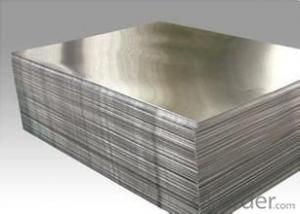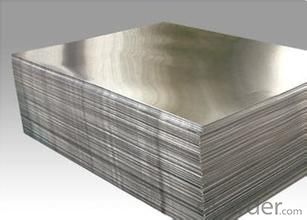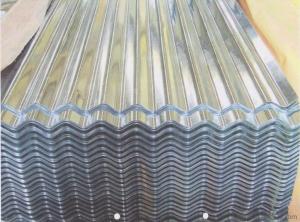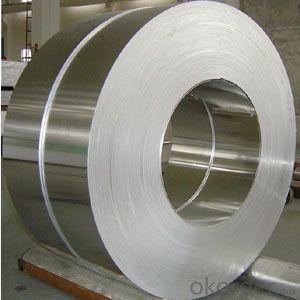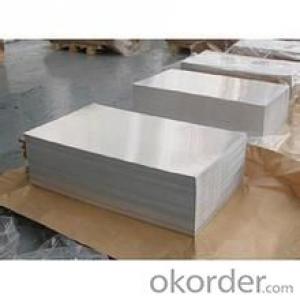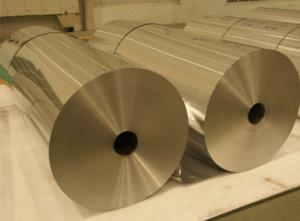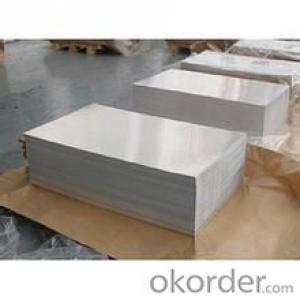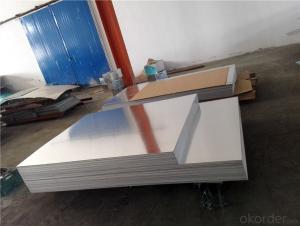Aluminum Sheet for Any Use
- Loading Port:
- China Main Port
- Payment Terms:
- TT OR LC
- Min Order Qty:
- -
- Supply Capability:
- -
OKorder Service Pledge
OKorder Financial Service
You Might Also Like
Aluminium foil acts as a total barrier to light and oxygen (which cause fats to oxidise or become rancid), odours and flavours, moistness, and germs, it is used broadly in food and pharmaceutical packaging. The purpose of aluminium is to make long-life packs (aseptic processing|aseptic packaging) for drinks and dairy goods, which allows storing without refrigeration. Aluminium foil containers and trays are used to bake pies and to pack takeaway meals, ready snacks and long life pet foods.
Aluminium foil is widely sold into the consumer market, often in rolls of 500 mm (20 in) width and several metres in length.It is used for wrapping food in order to preserve it, for example, when storing leftover food in a refrigerator (where it serves the additional purpose of preventing odour exchange), when taking sandwiches on a journey, or when selling some kinds of take-away or fast food. Tex-Mex restaurants in the United States, for example, typically provide take-away burritos wrapped in aluminium foil.
Aluminium foils thicker than 25 μm (1 mil) are impermeable to oxygen and water. Foils thinner than this become slightly permeable due to minute pinholes caused by the production process.
Aluminium foil has a shiny side and a matte side. The shiny side is produced when the aluminium is rolled during the final pass. It is difficult to produce rollers with a gap fine enough to cope with the foil gauge, therefore, for the final pass, two sheets are rolled at the same time, doubling the thickness of the gauge at entry to the rollers. When the sheets are later separated, the inside surface is dull, and the outside surface is shiny. This difference in the finish has led to the perception that favouring a side has an effect when cooking. While many believe that the different properties keep heat out when wrapped with the shiny finish facing out, and keep heat in with the shiny finish facing inwards, the actual difference is imperceptible without instrumentation.The reflectivity of bright aluminium foil is 88% while dull embossed foil is about 80%.
We provide a full range of precision aluminum strip for almost any application. We produce aluminum strip in a wide variety of alloys, including clad composites. Our aluminum strip can be produced in standard dimensions or custom made to your special requirements. We produce both imperial and metric units. We manufacture in compliance with the main international specifications, and tighter tolerances or custom tempers are available upon request. We offer various surface conditions, custom finishes (painting, anodizing, embossing), special processing, and multiple packaging options to meet our customer's unique requirements. The following is a summary of our capabilities.
Manufactured in compliance with the main international specifications and standards, including: Aluminum Association, ASTM, EN, and DIN.
We can also manufacture in compliance with other international standards including:ASME, SAE, AMS, AWS, FED, MIL, QQ, ISO, BS, AFNOR, JIS and GOST.
Manufactured in compliance with the main international specifications and standards.
Tighter tolerances are available upon request.
Aluminium (or aluminum; see spelling differences) is a chemical element in the boron group with symbol Al and atomic number 13. It is a silvery white, soft, ductile metal. Aluminium is the third most abundant element (after oxygen and silicon), and the most abundant metal in the Earth's crust. It makes up about 8% by weight of the Earth's solid surface. Aluminium metal is so chemically reactive that native specimens are rare and limited to extreme reducing environments. Instead, it is found combined in over 270 different minerals.The chief ore of aluminium is bauxite.
Aluminium is remarkable for the metal's low density and for its ability to resist corrosion due to the phenomenon of passivation. Structural components made from aluminium and its alloys are vital to the aerospace industry and are important in other areas of transportation and structural materials. The most useful compounds of aluminium, at least on a weight basis, are the oxides and sulfates.
Despite its prevalence in the environment, no known form of life uses aluminium salts metabolically. In keeping with its pervasiveness, aluminium is well tolerated by plants and animals. Owing to their prevalence, potential beneficial (or otherwise) biological roles of aluminium compounds are of continuing interest.
Coal (from the Old English term col, which has meant "mineral of fossilized carbon" since the 13th century)is a combustible black or brownish-black sedimentary rock usually occurring in rock strata in layers or veins called coal beds or coal seams. The harder forms, such as anthracite coal, can be regarded as metamorphic rock because of later exposure to elevated temperature and pressure. Coal is composed primarily of carbon along with variable quantities of other elements, chiefly hydrogen, sulfur, oxygen, and nitrogen.
Throughout history, coal has been used as an energy resource, primarily burned for the production of electricity and/or heat, and is also used for industrial purposes, such as refining metals. A fossil fuel, coal forms when dead plant matter is converted into peat, which in turn is converted into lignite, then sub-bituminous coal, after that bituminous coal, and lastly anthracite. This involves biological and geological processes that take place over a long period. The Energy Information Administration estimates coal reserves at 948×109 short tons (860 Gt).One estimate for resources is 18 000 Gt.
Coal is the largest source of energy for the generation of electricity worldwide, as well as one of the largest worldwide anthropogenic sources of carbon dioxide releases. In 1999, world gross carbon dioxide emissions from coal usage were 8,666 million tonnes of carbon dioxide.In 2011, world gross emissions from coal usage were 14,416 million tonnes.Coal-fired electric power generation emits around 2,000 pounds of carbon dioxide for every megawatt-hour generated, which is almost double the approximately 1100 pounds of carbon dioxide released by a natural gas-fired electric plant per megawatt-hour generated. Because of this higher carbon efficiency of natural gas generation, as the market in the United States has changed to reduce coal and increase natural gas generation, carbon dioxide emissions have fallen. Those measured in the first quarter of 2012 were the lowest of any recorded for the first quarter of any year since 1992.In 2013, the head of the UN climate agency advised that most of the world's coal reserves should be left in the ground to avoid catastrophic global warming.
Coal is extracted from the ground by coal mining, either underground by shaft mining, or at ground level by open pit mining extraction. Since 1983 the world top coal producer has been China.In 2011 China produced 3,520 million tonnes of coal – 49.5% of 7,695 million tonnes world coal production. In 2011 other large producers were United States (993 million tonnes), India (589), European Union (576) and Australia (416).[9] In 2010 the largest exporters were Australia with 328 million tonnes (27.1% of world coal export) and Indonesia with 316 million tonnes (26.1%),while the largest importers were Japan with 207 million tonnes (17.5% of world coal import), China with 195 million tonnes (16.6%) and South Korea with 126 million tonnes (10.7%).
- Q: if the sphere were perfectly round and the walls were highly reflective to visible light, what would happen
- Assume the walls are coated with silver, you are tiny compared to the sphere, you are wearing a silver suit with a tiny peep hole, and the light bulb does not absorb any of the reflected lightRed light would be reflected back at the bulb about 5% dimmer each time until the reflections approach zero brightnessViolet would be about 10% dimmer each timeSo the total brightness for red inside the sphere would be the brightness of the bulb times Σ (n 0 to ∞)(.95^n) 20 times the original brightnessFor blue, Σ (n 0 to ∞)(.95^n) 10So the red would be amplified about twice as much as the violet(This is a good example of the usefulness of Wolframalpha.) For an aluminum coating, the reflectivity is about 92% for violet and 90% for red.
- Q: I have a 2000 Jeep Cherokee sport and I have replaced the radiator 3 times (average lifespan 1.5 years)Every time it has failed at the top passenger side corner where the aluminum fins are soldered to the aluminum tubeNOT where aluminum meets the plastic.It was replaced by a professional with an OEM radiatorIs it possible that racking in the frame due to bad sway bar bushings or harsh Michigan roads could cause this problemSame location of the break I am not having over heating issues before radiator breaks.I am using correct coolant mixture.
- You should and always leave it in the aluminum tin!
- Q: 28.Based on their positions in the periodic table predict which atom from each of the following pairs has a larger ionization energy:Rb / F Be / Ba Ca / Fe Al / Mga) F, Be, Fe, Al c) F, Be, Fe, Mgb) Rb, Ba, Ca, Mg d) Rb, Ba, Ca, AlMy answer is A, but the right answer is CI don't understand why is Mg and not Al when Aluminum is closer to the noble gases and FluorinePlease explain to me why the answer is what it is.
- i've been straightening my hair since i was eleveni have thin hairmy hair is MAJORRLYYY curlyMy hair's actually pretty healthy still (:
- Q: This question asks for an explanation of the environmental effects caused by the process of smelting aluminum.
- <p>The environmental impact of smelting aluminum is significant. It is an energy-intensive process that contributes to greenhouse gas emissions, primarily due to the high electricity consumption required for the Hall-H茅roult process. This process also generates perfluorocarbons (PFCs), which are potent greenhouse gases. Additionally, the production of aluminum releases particulate matter and sulfur dioxide, contributing to air pollution. The extraction of bauxite, the primary source of aluminum, can lead to deforestation and habitat destruction. Moreover, the waste products, such as red mud, can cause water pollution if not properly managed. Overall, the smelting of aluminum has considerable environmental implications, necessitating the development of more sustainable practices in the industry.</p>
- Q: This question asks if there are differences in how long different types of aluminum cookware can last.
- <p>Yes, there are differences in the durability of different types of aluminum cookware. Anodized aluminum cookware is more durable and resistant to scratches and corrosion compared to non-anodized aluminum. Cast aluminum cookware is heavier and more durable than aluminum clad cookware, which is a layer of aluminum bonded to a stainless steel core. The thickness of the aluminum also affects durability, with thicker aluminum being more resistant to warping and lasting longer. Proper care and maintenance also play a significant role in the longevity of aluminum cookware.</p>
- Q: Expert: about 100 caliber aluminum tube, manual argon arc welding, single-sided welding, double sided forming technology. And welding process and welding method ~!
- Aluminum tube size 57*4*100; thank you all experts to answer the aluminum tube butt manual tungsten arc welding; single-sided welding double-sided forming technology......
- Q: I just came into a very nice 14 foot aluminum john boatIts in great shape but could very much use a paint jobI would like to repaint the boat and the trailer, and make it look new againI'm naming it the Screamin' SeamanI'm an artist on top of an angler, and plan on painting screaming tadpoles down the sides of it in various waysOne will have an anchor tatoo, another with a cigar, another with a hook instead of a tailetcetcCan someone help me get started with this?I'm used to painting on canvas, not aluminum.
- i just painted mine i sanded it down really good to get all the paint chips off then i used a wagner power painter and used oil based paint it wont wear off as fast but make sure you primer it first make sure to clean the power sprayer because oil based paint makes huge messes we painted ours on the floor one side at a time looks great too!!
- Q: Are you concerned about consuming or absorbing the neurotoxin aluminum? What measures do you take to avoid them?Sources:saltbaking powderAs well as in some: tooth fillingsdeodorantantacidsSome studies indicate that patients with Alzheimer's have traces of aluminum in their brains.
- Yes I am. I avoid drinking sodas and juices from cans - Aluminum dissolves due to the acidic content of the soda or juice I don't use aluminum foil to wrap food - there will be some migration of aluminum into the food. I don't use aluminum cooking ware - use stainless steel instead. Don't use Aluminum antacids.
- Q: does any one out there know the recipie to hardees or bojangles eggs i like them, they are very good! i need the recipie plz help me!
- Well I live in ny so I would just stick them in the snowbank.try the freezer.
Send your message to us
Aluminum Sheet for Any Use
- Loading Port:
- China Main Port
- Payment Terms:
- TT OR LC
- Min Order Qty:
- -
- Supply Capability:
- -
OKorder Service Pledge
OKorder Financial Service
Similar products
Hot products
Hot Searches
Related keywords
